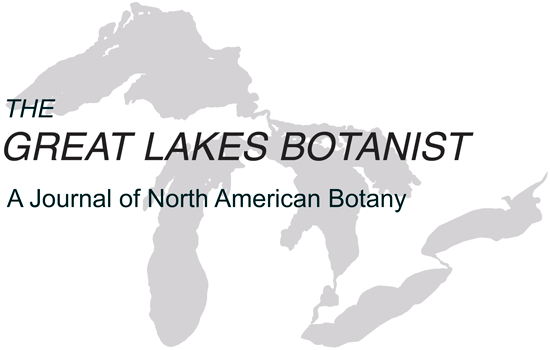Local floras are a particularly useful contribution to our knowledge of the plant life of the Great Lakes region, especially when they cover a well-defined ecological landscape, and even more so when that habitat is under threat. The first article in this issue belongs to that category, providing an account of the flora of the barrens in northwestern Wisconsin. Evaluating eight discrete sites within the barrens region, the authors employ various quantitative and qualitative assessments to compare the sites on a gradient to determine the relative influence of latitude and the surrounding habitats on the flora and its diversity within the barrens region, as well as presenting a complete floristic list keyed to the various sites examined.
Next is another article in the series of studies of the Grand Rapids flora and how it has changed since Emma Cole’s 1901 Grand Rapids Flora. This entry is an assessment of remnant floodplain habitats that, although they have been drastically impacted by development and other human usages in the area, nevertheless still harbor unique assemblages of native biodiversity. By comparing today’s flora of these remnants with the information available to Emma Cole over 120 years ago, the article reviews the changes that have taken place over time and provides important information that will be useful in future preservation and restoration efforts.
The Michigan Botanical Society (then the Michigan Botanical Club) initiated the Michigan Big Tree Program in 1956 that maintains a register of the largest trees of each species in the state. The third article, authored by the current Big Tree coordinator, Ted Reuschel, describes the history of the Big Tree Program, explains its objectives and operations and the criteria used to add individual trees to the register. In addition, the article details how the register may be searched and describes how individuals may contribute to the register, either by nominating individual trees or by acting as volunteer certifiers.
In much of the Midwest, forests are limited to small fragments. Preservation and maintenance of these fragments is essential, and an important basis for this is understanding the diversity and status and their floras and their ecological conditions. The fourth article, which presents a report on ecological and floristic plant surveys of one such fragment, now preserved as the Little Wabash River Nature Preserve in northeastern Indiana, is a contribution to this important effort. Although the property has been subjected to substantial human influence, the authors conclude on the basis of their studies that it is worthy of preservation.
Malcolm MacFarlane’s long-term studies of the genus Botrychium in northwestern Minnesota (previously reported in Volume 60, pages 82–96, of this journal) have resulted in significant new records for an uncommon species, B. crenulatum, reported in a Noteworthy Collections article in this issue.
This is followed by two reviews of new books that each cover a particular group of plants. The first is an updated edition of a classic manual of the aquatic and wetland plants of northeastern North America by Garrett E. Crow, a recent past president of the Michigan Botanical Society and a long-time student of aquatic plants along with his colleague, C. Barre Hellquist. This work will be a much-needed resource for all those who work with, or who simply enjoy learning about, wetlands and their plant life. The second is another excellent manual of a group of Minnesota plants by Welby R. Smith, the Minnesota state botanist, this time on the ferns and lycophytes. It follows equally excellent earlier books by Smith on the orchids, the trees and shrubs, and the sedges and rushes.
Climate change is widely considered to be a major challenge facing the world, and by many as “the greatest challenge humans have ever faced” (in the words of Bill McKibben). It has also been characterized as an existential crisis facing humankind. More than that, it is also a crisis facing the natural world, with potential severe impacts on and alterations of habitats and posing a threat of extinction to many plants and animals. It is therefore a topic of great interest to all who study nature. The final piece in this issue reviews three books on climate change and is intended to be the first of several reviews covering various aspects of climate change. This first review looks at three books that provide, in different degrees of thoroughness, an overview of the general field of climate change. Future reviews will cover more discrete aspects of climate change, such as the science of climate change, impacts on the physical and natural world, denialism, the effect on plants, social impacts, alternative energy sources, the economics of climate change, and political and policy solutions.
